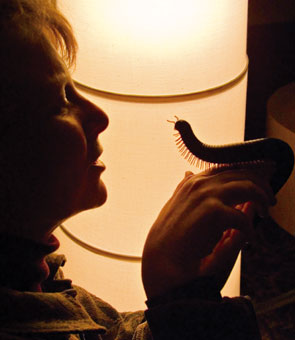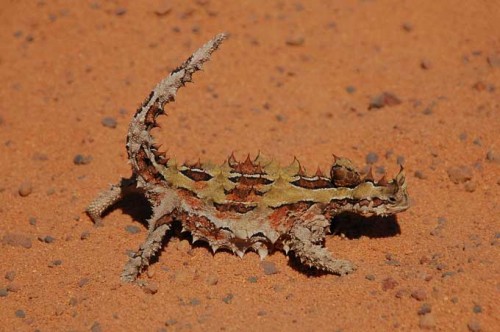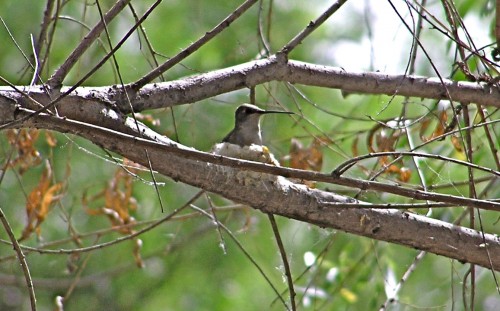Biomimicry: when Monkey-see-Monkey-do is a good thing
 Tuesday night E and I heard a biomimicry expert speak at ASU. Her name is Janine Benyus, and she’s a natural history author who’s been documenting the emerging cross-disciplinary field of biomimicry. Before hearing her talk, I had a very primitive notion of biomimicry: “Dude, did you know a spider’s silk is 10 times stronger than steel — like, if we could do that, how cool would it be?” And, like most over-simplified notions, it’s both right and not so much.
Tuesday night E and I heard a biomimicry expert speak at ASU. Her name is Janine Benyus, and she’s a natural history author who’s been documenting the emerging cross-disciplinary field of biomimicry. Before hearing her talk, I had a very primitive notion of biomimicry: “Dude, did you know a spider’s silk is 10 times stronger than steel — like, if we could do that, how cool would it be?” And, like most over-simplified notions, it’s both right and not so much.
Here is the Wikipedia definition of biomimicry: Biomimicry (from bios, meaning life, and mimesis, meaning [imitation]) is a relatively new science that studies nature, its models, systems, processes and elements and then imitates or takes creative inspiration from them to solve human problems sustainably.
Benyus’s presentation was an overview of some of the work being done RIGHT NOW on deriving high-tech solutions to problems in engineering, health, agriculture, energy production and many other fields by observing organisms and natural systems. Her idea: “We need to re-design everything”, as she admits is a tall order, but from her examples, there are a lot of smart people working on it 24/7. Here are some of the things she mentioned:
- significantly increasing efficiency of wind-turbine blades by designing them with bumps like the tubercules on the flippers of Humpback whales
- making strong and very water-resistant plywood without formaldehyde using a soy-based adhesive similar to the glue mussels use to adhere to underwater rocks
- An aerodynamic 70mpg Mercedes car that looks like a box-fish and has an interior steel frame designed
 by bone-mimicking software (check it out on this link)
by bone-mimicking software (check it out on this link) - apartment buildings with intramural structural cooling based on the cooling tunnels in African termite towers

- water-gathering technologies for arid areas based on highly efficient moisture-gathering organisms like a Namib beetle whose wings are capable of sieving fog-droplets out of a 50mph wind, and the Thorny “devil” (a horned lizard like reptile of the Australian desert) whose scale-borders act as capillary channels and can direct even tiny quantities of water, like dew, against gravity to its mouth.
- exterior surfaces for structures based on the pleated form of many cactus like saguaro, which are not only self-shading, but also direct rain to where it’s needed at the roots of the plant.
- self-cleaning paint for buildings and autos that works using the “lotus effect”: tiny surface bumps allow rain drops to skip down a wall, washing away dirt without using detergents, as do the surfaces of many plant leaves like water lotus.
These are only a small fraction of the projects she covered. There’s more at the website Asknature.org, which is designed not only to introduce the public to the concept of biomimicry, but has a resource section for connecting people with nature-based strategies for the problems they need to solve: “sticking to”, “self-cleaning”, “break down,” etc.
What struck me most (apart from the really smart ideas biomimicry people are coming up with) were two things: 1) Biomimicry is a fantastic example of why Basic Research is important and should be funded. The ideas involved are not vague tree-hugging notions of how we should all “learn from the animals”, but fact-based high-tech products, companies, projects, and enterprises created by biologists, engineers, entrepreneurs, designers, scientists and  others working together: commerce and science, business and academia tightly and productively intertwined. And they arise from basic research: many are launched from studies that are undertaken to further our knowlegde of the world around us, and not originally intended to result in commercial applications. And 2) The Arizona angle. Not only did Benyus point out how the desert itself is full of organisms surviving under adverse conditions and so is a perfect system to study and learn from, but also how many people in biomimicry are working at Arizona State University. Over and over, she mentioned names of scientists, teachers, and students who were sitting around us in the audience. While this made me proud of ASU, it was painful too in light of the ongoing budget crisis created by partisan factions in the Arizona state legislature. Even as we sat there listening to all the social, economic, scientific, and environmental advances ASU personnel are making in schools and departments from Design to Chemistry, money was being ripped away short-sightedly from those very programs and people in the name of fiscal responsibility.
others working together: commerce and science, business and academia tightly and productively intertwined. And they arise from basic research: many are launched from studies that are undertaken to further our knowlegde of the world around us, and not originally intended to result in commercial applications. And 2) The Arizona angle. Not only did Benyus point out how the desert itself is full of organisms surviving under adverse conditions and so is a perfect system to study and learn from, but also how many people in biomimicry are working at Arizona State University. Over and over, she mentioned names of scientists, teachers, and students who were sitting around us in the audience. While this made me proud of ASU, it was painful too in light of the ongoing budget crisis created by partisan factions in the Arizona state legislature. Even as we sat there listening to all the social, economic, scientific, and environmental advances ASU personnel are making in schools and departments from Design to Chemistry, money was being ripped away short-sightedly from those very programs and people in the name of fiscal responsibility.
Bad bad bad monkeys — what are the politicians thinking? “Monkey see monkey do” — biomimicry and its educational foundations and commercial development — deserves staunch support, for the good of the future. And Arizona, with its universities already deeply involved in such research, could be a leader in biomimicry studies and industry. But only with a well-nourished educational system. As Benyus said, the defiinition of the success of a species is not whether its offspring survive, but whether its 10-thousandth generation survives. To do that, a species must take care of where its offspring will live. This is what a bird does when it builds a nest, this is what nature does on both a grand and a small scale: “Life creates conditions conducive to life.” That is the lesson for individuals, for people in charge of policy and states: it is the lesson for the ages.
of the success of a species is not whether its offspring survive, but whether its 10-thousandth generation survives. To do that, a species must take care of where its offspring will live. This is what a bird does when it builds a nest, this is what nature does on both a grand and a small scale: “Life creates conditions conducive to life.” That is the lesson for individuals, for people in charge of policy and states: it is the lesson for the ages.
But in the interest of happy thoughts, I’ll leave you with this final fact, humorous visual image, and new word: Supposedly, the “stiction” of a fully engaged gecko could support 200 pounds. Imaging suspending a porky politician — by his waist of course — from the ceiling, with a just a gecko! How sustainable is that?
Photos: I’m uncertain whom to credit the great photo of Ms. Benyus and a very large milipede to. But in case this applies, I will credit AskNature.org, a project of The Biomimicry Institute. The photo of the Thorny Devil is from Wikipedia, and is by Wouter. The female hummer is a Black-chinned girl on a nest built above a footpath at the Nature Conservancy’s Hassayampa Preserve near Wickenburg, AZ, by A. Shock.
